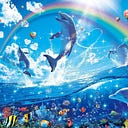
(C-Print, 70 x 105 cm, Edition: 1/3 + 1 AP)
Doubts about its credibility are as old as photography itself. It is not only since digital photography and modern image processing that the seeming objectivity of the medium has deceived us.
Before you click on the following link or continue reading, I ask you to guess where the title-giving coordinates of Charrière’s photo are located.

The photos show piles of ground on construction sites in Berlin, which — treated and prepared by Charrière with practical means such as flour and a fire extinguisher and photographed from a worm’s eye view — look like a sublime mountain landscape.
I encountered this series of photographs in May 2020 in the “Models of Nature in Contemporary Photography” exhibition shortly after the reopening at the Alfred Ehrhardt Foundation Berlin. The exhibition focussed on the cultural discourse around nature perception (a short contribution by the curator). Instead, let us discuss two other aspects of this captivating illusion.
Practical Effects
Charrière’s miniature mountain landscape demonstrates that depicting nature at scale using simple practical effects from the era of analog film and photography has lost none of its beauty and might.
Think, for example, of the Empire’s attack on Hoth in “Star Wars — The Empire Strikes Back,” which was built and staged at model scale and is still as visually stunning today as it was in 1980.
In the context of the exhibition, however, this creative process remains hidden. Other participating artists do not reveal their methods to preserve the illusion and highlight its subjectivity.
Reception and Expectations
Encountering Charrière’s landscapes presented in a context such as this article, with an additional explanation, allows you to perceive the two motifs individually and alternately. If you step back and suppress the knowledge of the photographs origin, the mountain landscape reappears. If you take a closer look and zoom in on the supposed details, you will again identify what is depicted as the heap of dirt at Gleisdreieck Berlin.
The three panoramas by Charrière were exhibited in a gallery in Auguststraße in Berlin Mitte. Initial reactions often involved a romanticized understanding of nature; the visitors perception was characterized by a particular emotionality you might expect of someone watching a National Geographic documentary about some bird species about to go extinct. Topics like vacation or fernweh were brought up frequently. It seems like the exhibit’s location automatically signifies a certain gravity. This contradiction to the banality of the actual motif repeatedly led to great astonishment whenever the illusion was revealed.




